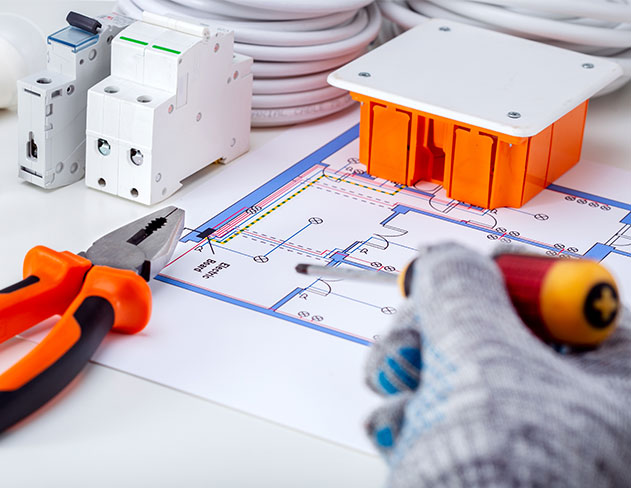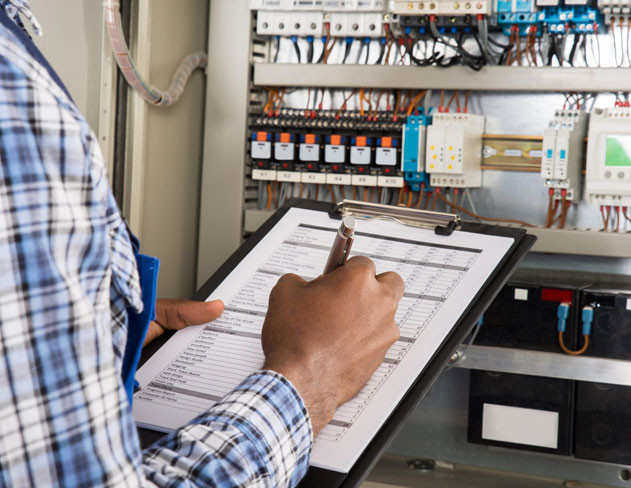The Most Common EICR Faults and How We Fix Them
Discover the most prevalent EICR faults we deal with daily, from circuit overloads to outdated systems, and learn the expert solutions to ensure electrical safety. Dive deep into the importance of EICR, the role of certified electricians, and the cost implications of fixes.
Circuit Overloads
Circuit overloads can be extremely dangerous. They happen when too many electrical devices draw power from the same circuit simultaneously, overloading it beyond its rated capacity. This causes the circuit breaker to trip or fuses to blow, interrupting power. It also leads to overheated wires, which can start electrical fires.
The immediate solution is to upgrade the circuit to a higher amperage rating, or balance the electrical load across multiple circuits. An electrician can determine the actual load on a circuit and install new breaker panels or wiring as needed. Attempting DIY electrical work often leads to more hazards, so calling in a certified professional is critical.
Damaged or Exposed Wiring
Wiring inside walls or electrical boxes can damage due to age, pests, improper installation, or excessive loads. Bare wires, loose connections, and fraying or sliced insulation can all cause shorts, shocks, and fires.
Electricians carefully inspect for any compromised wiring and will replace entire wire runs if necessary. They also ensure wires are properly routed and secured, with tight, enclosed connections. Damaged wiring must be addressed immediately to avoid potential shocks or fire hazards.
Absence of RCD (Residual Current Device)
An RCD is a crucial safety device that instantly breaks the electrical circuit if it detects dangerous earth fault currents.
RCDs greatly reduce the risk of severe shocks and electrocutions. Modern safety standards require RCD protection for nearly all circuits.
For older installations lacking RCDs, an electrician can assess the electrical system and install suitable RCD protection devices. They determine the right locations and types of RCDs and the proper installation methods. Attempting to add RCDs without professional knowledge risks improperly protecting the circuits.
Delving Deeper: The Most Common EICR Faults And How We Fix Them – Understanding the Root Causes
Outdated Electrical Systems
Older electrical systems often lack the capacity and safety features of modern standards. Warning signs include fuse boxes, undersized wiring, two-prong outlets, and an absence of RCD protection. Outdated systems increase fire risks and reduce performance.
According to Electrical Safety First, 53.4% of all accidental domestic fires in England had an electrical origin in 2018/19. This highlights the importance of updating ageing electrical installations.
Modernising solves immediate issues and prevents future hazards. Electricians can fully evaluate systems to identify antiquated or unsuitable components.
They then recommend bringing the property up to current codes and standards. This often requires new consumer units, circuit breakers, wiring, outlets, and safety devices.
Faulty Electrical Installations
Installation mistakes happen more often than homeowners realise. Even professional electricians can make errors. DIY attempts frequently result in unsafe conditions due to lack of skills and knowledge.
Common mistakes include undersized wiring, unsecured connections, improper grounding, and incorrectly rated overcurrent protection. These issues can lead to overloaded circuits, shocks, and fire hazards. According to Electrical Safety First, there was a 400% rise in dangerous interference with energy metres and equipment in homes in 2018 compared to 2015. This further highlights the risks of DIY electrical work.
The solution is thoroughly inspecting and testing the installation to identify any deficiencies. These are then meticulously corrected to ensure completely safe and compliant electrical systems.
Comprehensive Solutions for Long-Term Safety
Upgrading Outdated Systems
To modernise electrical systems, components that often need a replacement include:
- Fuse boxes – These older style panels use fuses that must be replaced when they blow, rather than resetting a circuit breaker. Fuse boxes have a more limited capacity and lack modern safety features. Upgrading to a circuit breaker panel provides increased circuit capacity, overcurrent protection, and easier resetting of tripped breakers.
- Undersized wiring – Older wiring is often rated for 15 or 20 amps, insufficient for today’s electrical loads. Replacing with new wiring rated for 30 amps or higher allows for running more high-wattage appliances and devices simultaneously. It reduces the chance of overloads.
- Two-prong outlets – Outlets without a grounding pin lack a safe path for fault currents. Upgrading to modern grounded outlets improves safety and allows 3-prong plugs to be used.
- Lack of RCD protection – Installing RCDs protects against electrocution and shocks. RCDs should be installed for nearly all circuits, especially those supplying sockets, external wiring, or water sources.
The Role of a Certified Electrician in EICR Corrections
Electrical work can seem straightforward, but looks are deceiving. There are many intricacies and safety risks involved. That’s why expertise and qualifications are so important for proper, compliant electrical work.
A certified electrician has extensive training and experience. They possess the specialised knowledge to inspect systems and thoroughly identify any issues or risks. Electricians also understand the most effective correction methods to apply for specific problems according to electrical regulations.
The process an EICR follows includes:
- Comprehensive inspection of all system components, checking for any deficiencies.
- Diagnostic testing using proper equipment to detect any hidden issues.
- Detailed evaluation of the system condition and remaining service life.
- Development of a correction plan addressing all discovered faults and risk areas.
- Meticulous remediation work performed to the highest standards.
- Certification of the corrected system as fully compliant and safe.
According to Electrical Safety First, the rate of dangerous electrical installations in UK housing jumped from 1 in 10 in 2012 to 1 in 5 in 2017. Yet the UK maintains high safety standards overall. This highlights the importance of hiring qualified professionals rather than attempting unsafe DIY fixes.
Upgrading provides increased capacity to handle higher electrical loads from modern devices and appliances. It also improves safety, reliability, and energy efficiency. Though upgrades require an initial investment, they improve the value of a property.
Rectifying Faulty Installations
Fixing faulty installations thoroughly involves:
- Meticulous visual inspection of all system components to spot any apparent flaws in the wiring, connections, or layout.
- Testing connections under realistic loads, not just with a voltmeter alone. Issues like loose connections often only become noticeable when operating near capacity.
- Any identified faults must be completely corrected. For wiring issues, this may require new wire runs. For connection issues, all terminals and joins should be redone properly.
- Confirming the finished installation meets all relevant local regulations and electrical codes. This ensures safety for occupants and future compliance.
DIY attempts often compound issues and can have tragic consequences. According to Electrical Safety First, tampering with metres caused over 2800 house fires, 20000 gas leaks, and 350 electrocutions in 2018. Always hire a qualified electrician to ensure completely safe and proper electrical work.
Cost Implications of EICR Report Fixes
The costs to remedy issues identified in an EICR report can vary substantially depending on the specifics of each job. Here are typical price ranges for common fixes in the London area:
- Upgrading a fuse box to a circuit breaker panel – £800 to £1200
- Installing RCD protection for additional circuits – £150 to £250 per circuit
- Rewiring a standard room – £1000 to £2000
- Complete rewire of an average house – £5000 to £10000
- Adding a new circuit – £150 to £800
- Upgrading sockets and switches – £200 to £800
While the costs may seem high, proactive maintenance is almost always less expensive than emergency repairs or fire damage remediation. Regular electrical inspections and system upgrades during renovations or when moving into older homes allows defects to be addressed in a planned, cost-effective manner. It provides long-term financial benefits alongside safety.
Tips for Ensuring a Positive EICR Outcome
There are several best practices homeowners and property managers can follow to get the most out of the EICR process:
- Schedule regular electrical inspections every 5 years or so to catch issues early before they become major hazards. Staying on top of maintenance is safer and more cost effective.
- When renovating or upgrading, use high quality components that meet the latest standards. This prevents having to replace subpar electrical parts later on.
- Never attempt DIY electrical work unless fully qualified. Tampering by untrained individuals often creates serious safety issues. According to Electrical Safety First, over 51% of recalled electrical products purchased online in 2016 were counterfeit and dangerous.
- Hire a reputable NICEIC or NAPIT approved electrician to perform high quality, compliant work. Verify their certification and experience.
- Follow all recommendations from the electrician to properly correct identified issues. Don’t cut corners, your safety is paramount
Regular inspections paired with properly addressing problems ensures an electrical system remains safe and compliant over its service life. Understand the significance of ongoing maintenance between EICR inspections in our dedicated guide.
Conclusion- The Most Common EICR Faults And How We Fix Them
EICR reports reveal critical information about potential electrical hazards in a property. While some issues may seem quick and easy to remedy, employing certified professionals for all remediation work is vital. DIY attempts often exacerbate rather than solve problems.
Electrical safety should never be compromised. The risks of shocks, electrocution, fires, and even death are too severe. By understanding the most common EICR issues and their comprehensive solutions, homeowners and managers can ensure their electrical systems are completely safe for all occupants.
Staying current with inspections and proactively addressing any identified problems is essential. People’s lives regularly depend on the safety of underlying electrical installations. Your diligence with electrical maintenance and hiring qualified electricians provides your tenants, family, and yourself with the level of protection and peace of mind you deserve.

